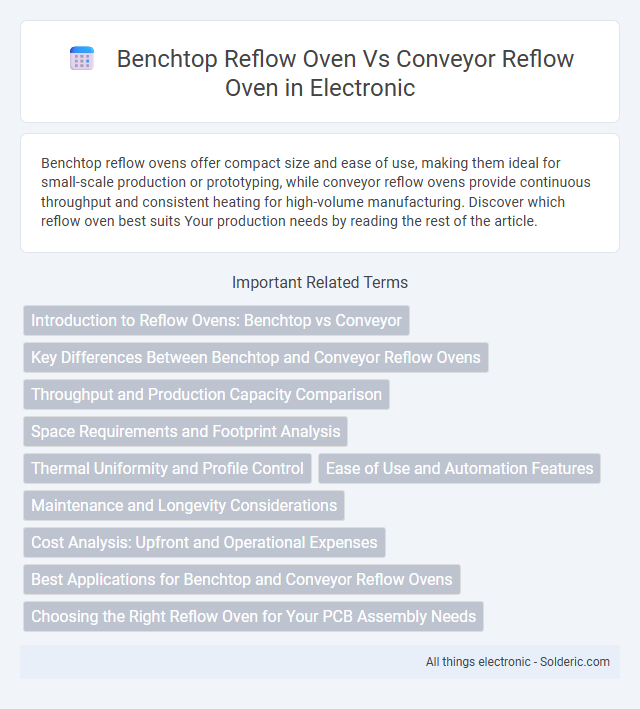Benchtop reflow ovens offer compact size and ease of use, making them ideal for small-scale production or prototyping, while conveyor reflow ovens provide continuous throughput and consistent heating for high-volume manufacturing. Discover which reflow oven best suits Your production needs by reading the rest of the article.
Comparison Table
| Feature | Benchtop Reflow Oven | Conveyor Reflow Oven |
|---|---|---|
| Size | Compact, fits on benchtop | Large, floor-standing |
| Throughput | Low to medium volume | High volume, continuous operation |
| Cost | Lower initial investment | Higher upfront cost |
| Footprint | Small, space-saving | Large, requires dedicated space |
| Application | Prototyping, small batch production | Mass production, high efficiency |
| Heating Method | Convection or infrared heating | Conveyor belt with controlled temperature zones |
| Process Control | Manual or semi-automatic | Fully automated with precise control |
| Maintenance | Easy and low cost | Complex, requires specialized service |
| Typical Users | R&D labs, small manufacturers | Large-scale electronics manufacturers |
Introduction to Reflow Ovens: Benchtop vs Conveyor
Benchtop reflow ovens offer a compact, cost-effective solution ideal for small-scale PCB assembly, providing precise temperature control within a limited workspace. Conveyor reflow ovens cater to high-volume production lines, featuring continuous thermal profiling and consistent heating for improved throughput and repeatability. Selecting between benchtop and conveyor models depends on production scale, footprint requirements, and process automation needs.
Key Differences Between Benchtop and Conveyor Reflow Ovens
Benchtop reflow ovens are compact, designed for low- to medium-volume PCB soldering with shorter heating zones and manual loading, making them ideal for prototyping and small batch production. Conveyor reflow ovens feature continuous feed systems with multiple controlled heating zones, enabling precise thermal profiling and high throughput suitable for mass production. The core difference lies in scalability and automation, where benchtop models prioritize flexibility and space-saving, while conveyor systems emphasize efficiency and consistency in large-scale manufacturing.
Throughput and Production Capacity Comparison
Benchtop reflow ovens offer lower throughput and production capacity, making them ideal for small-scale or prototype soldering tasks. Conveyor reflow ovens provide continuous processing with higher throughput rates, suited for mass production and large-volume PCB assembly. Your choice depends on the required production capacity and workflow efficiency demands.
Space Requirements and Footprint Analysis
Benchtop reflow ovens require significantly less space, making them ideal for small-scale production and laboratories with limited floor area, typically occupying around 1 to 2 square feet. Conveyor reflow ovens demand larger footprints due to their extended conveyor belts and multiple heating zones, often requiring 10 to 20 square feet or more depending on the model. The compact size of benchtop ovens supports space-efficiency in tight workspaces, while conveyor ovens suit high-volume manufacturing with dedicated floor space.
Thermal Uniformity and Profile Control
Benchtop reflow ovens typically offer precise thermal uniformity within a compact chamber, ensuring consistent temperature distribution for small to medium-sized PCB batches. Conveyor reflow ovens excel in thermal profile control through adjustable multi-zone heating, enabling continuous processing and accommodating varying PCB sizes and complexities with high repeatability. Both systems utilize advanced thermal management technologies, but conveyor ovens provide superior scalability and flexibility in maintaining optimal temperature profiles for large-scale production runs.
Ease of Use and Automation Features
Benchtop reflow ovens offer straightforward manual controls ideal for small-scale production or prototyping, allowing easy adjustment of temperature profiles without complex programming. Conveyor reflow ovens provide advanced automation features such as programmable conveyor speeds and integrated cooling zones, enabling consistent, high-volume throughput with minimal operator intervention. The choice depends on balancing simplicity and flexibility in benchtop models against the high-efficiency, automated process control of conveyor systems.
Maintenance and Longevity Considerations
Benchtop reflow ovens require less intensive maintenance due to their compact size and simpler mechanical components, making them ideal for small-scale or prototyping environments. Conveyor reflow ovens, designed for high-volume production, necessitate regular calibration, belt cleaning, and component inspections to ensure consistent thermal profiles and prevent downtime. The longevity of conveyor ovens often surpasses benchtop models, supported by robust build quality and replaceable parts tailored for continuous industrial use.
Cost Analysis: Upfront and Operational Expenses
Benchtop reflow ovens typically have a lower upfront cost, ranging from $1,000 to $5,000, making them ideal for small-scale production or prototyping. Conveyor reflow ovens, with prices often exceeding $20,000, incur higher initial investment but offer greater throughput and automation efficiencies that reduce long-term operational expenses. Operational costs for benchtop ovens are generally higher per unit due to manual handling and limited capacity, whereas conveyor ovens benefit from energy-efficient designs and continuous production, lowering cost per board over time.
Best Applications for Benchtop and Conveyor Reflow Ovens
Benchtop reflow ovens are best suited for small-scale production, prototyping, and laboratory testing due to their compact size and ease of use. Conveyor reflow ovens excel in high-volume manufacturing environments, offering consistent thermal profiles and automated throughput for large batches. Both oven types support surface mount technology (SMT) assembly, with benchtop models ideal for low to medium volumes and conveyor systems optimized for mass production.
Choosing the Right Reflow Oven for Your PCB Assembly Needs
Benchtop reflow ovens offer compact design and precise temperature control, ideal for small-scale PCB assembly and prototyping, while conveyor reflow ovens provide high throughput and consistent heating suitable for mass production environments. Evaluating production volume, space availability, and budget constraints helps determine the optimal choice between these oven types. Selecting the right reflow oven enhances soldering quality, reduces defects, and improves overall PCB assembly efficiency.
Benchtop reflow oven vs conveyor reflow oven Infographic

 solderic.com
solderic.com